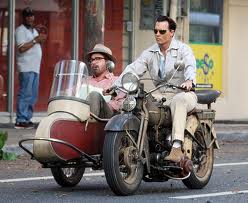 Martha Marcy May Marlene, starring Elizabeth Olsen:
Martha Marcy May Marlene, starring Elizabeth Olsen:
Steeped in fear, paranoia, and dread, Martha Marcy May Marlene is a tidy and compelling psychological thriller by writer-director Sean Durkin that deftly charts one woman’s shattered psyche. It’s one of the best such films since Roman Polanski’s Repulsion or Otto Preminger’s Bunny Lake is Missing, but much more accessible.
Elizabeth Olsen (younger sister of Mary Kate and Ashley Olsen) stars as Martha, a twentysomething young woman who falls into the orbit of a small cult and its charismatic and manipulative leader, Patrick (a chilling turn by the gifted John Hawkes). Tinted with shades of Charles Manson and David Koresh (but by no means a derivative character), Patrick obliterates his followers former identities and molds them to his will so completely that they act without question or hesitation. Their set-up resembles a communal farm on the surface; beind the scenes it’s an exploitive and predatory place.
As the story opens, Martha escapes the “family” and reunites with her estranged sister Lucy (Sarah Paulson) and her husband Ted (Hugh Dancy), trading one domineering household for another. The two are self-absorbed, tightly wound, and thoroughly caught up in their own facile lives, completely incapable of reading between the lines and seeing that something is desperately wrong with Martha as she slides swiftly towards a breakdown.
In flashback, we’re made privy to Martha’s induction into Patrick’s group, her experiences within it, and the events that drove her from it. All the while, we’re left to determine what drove her to it in the first place, whether or not her fears of never being able to escape it are founded, and to what her experiences have left her psychologically scarred.
It is the kind of story that depends on its lead actress, and Olsen carries the film nicely. She displays an utterly believable wide-eyed and enigmatic vulnerability, and is so tuned-in to her role and gives such a nuanced and fearless performance that it’s difficult to believe this is her feature film debut. She carries herself like a seasoned pro. It’s also Durkin’s first feature as well, and he too impresses, directing with a sure hand from a tightly written and carefully plotted script.
The movie also draws power from Jody Lee Lipes’ impeccable editing, with scenes of the past and present that seamlessly bleed together in a manner that often catches us off guard and clues us in to Martha’s delicate, teetering state of mind. By the time it reaches a disturbingly ambiguous conclusion, we’ve been subjected a very deep, very unsettling dive into a broken soul.
The Rum Diary, starring Johnny Depp:
 The notion of Johnny Depp in another movie based on a novel by Hunter S. Thompson sets a certain level of expectation, thanks to the actor’s memorable turn in Terry Gilliam’s surreal, chaotic 1998 adaptation of Fear and Loathing in Las Vegas. Viewers going into Depp and writer-director Bruce Robinson’s version of Thompson’s The Rum Diary will be either pleased or disappointed to find less of the same, depending on their preference. Fear and Loathing in San Juan it ain’t, nor is it a great movie; however, it is an intriguing (if somewhat thin) origin story of a gonzo journalist.
The notion of Johnny Depp in another movie based on a novel by Hunter S. Thompson sets a certain level of expectation, thanks to the actor’s memorable turn in Terry Gilliam’s surreal, chaotic 1998 adaptation of Fear and Loathing in Las Vegas. Viewers going into Depp and writer-director Bruce Robinson’s version of Thompson’s The Rum Diary will be either pleased or disappointed to find less of the same, depending on their preference. Fear and Loathing in San Juan it ain’t, nor is it a great movie; however, it is an intriguing (if somewhat thin) origin story of a gonzo journalist.
Depp stars as Paul Kemp, an idealized caricature of Thompson, (read: a less dissolute Raoul Duke) who arrives in San Juan Puerto Rico in 1960 to take a job at the local paper. It’s a rag that’s been circling the drain for some time, run by a cynical editor (Richard Jenkins under an unintentionally horrendous toupee) who hates his staff as much as they hate him. He immediately flags Kemp as trouble, but gives him the job anyway, mainly because he was the only one who applied for it.
Kemp quickly makes friends with fellow malcontents Robert Sala (Michael Rispoli), a staff photographer, and Moburg (Giovanni Ribisi), a long-since fired reporter who has taken alcoholism to new and dizzying heights. He also falls into the path of Sanderson (Aaron Eckhart), a property developer involved in some shady deals with even shadier politicians. Kemp agrees to work for him, partly for the money but mostly because he’s smitten with Sanderson’s free-spirited fiancee, Chenault (Amber Heard). Wackiness and heavy drinking ensue.
The story is pseudo-semi-autobiographical; Thompson ventured down to San Juan in 1959 seeking a job at the San Juan Star at the callow age of 22, but was turned down. (Having previously been fired from Time for insubordination and the Middletown Daily Record for assassinating a vending machine probably didn’t help.) It (or at least the motion picture version) is also a little unfocused. There is purpose to it – in between drunken excursions into squalid misadventure, Kemp tries to rally a decaying press corps into battle for the little guy against a greed-fueled Goliath — but the story, like Kemp, drifts through a haze towards a vague notion of, well, something.
There are strong moments, usually on the comedy side, and Robinson does an excellent job of infusing the movie with the right amount of seediness. The filmmaker made an indelible name for himself in 1987 with the thematically similar Withnail & I. That makes him the obvious choice to direct The Rum Diary, though not necessarily the best one, as he sometimes seems to be emulating the former to varying degrees of success.
Depp was a close friend of Thompson’s during the last decade or so of his life, and knew just as well as most others, if not better. He was instrumental getting the novel published in 1998, and has been guiding the movie version through production since then. He doesn’t build his performance around his performance around Thompson’s mannerisms the way he did in Fear and Loathing; instead, he infuses Kemp with some of Thompson’s ethos. “I smell bastards, and truth,” he says near the film’s conclusion. “I smell ink.” It sums up Thompson — or at least his legend — rather nicely.





